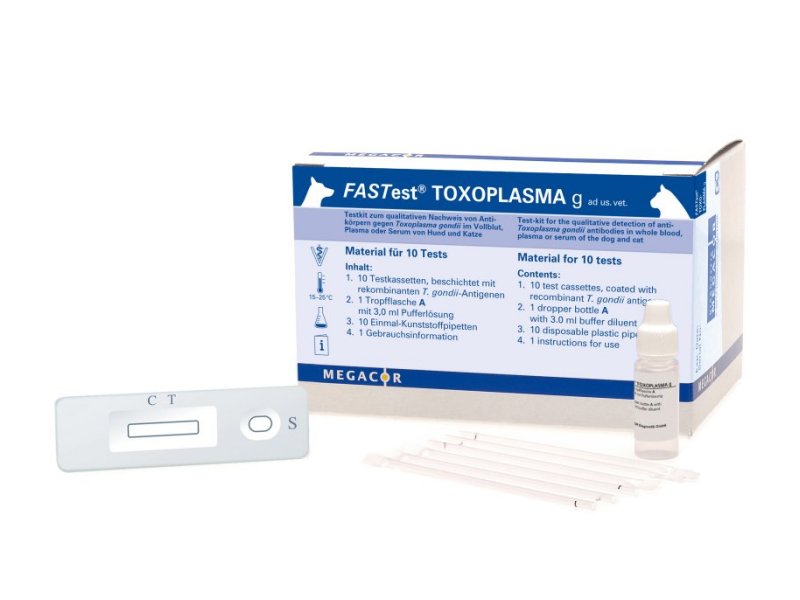Description
Qualitative Detection Of IgG Antibodies Against Toxoplasma gondii
Test applicable to: Dog and Cat
Sample: Whole Blood, Plasma or Serum
FASTest TOXOPLASMA g is a test for the qualitative detection of Toxoplasma gondii IgG antibodies in dogs and cats.
Test Principle
FASTest TOXOPLASMA g is based on an immunochromatographic “lateral flow” principle. T.gondii antibodies in the sample migrate along the nitrocellulose membrane and bind to fixed recombinant T. gondii antigens conjugated with gold particles forming a pink/purple coloured TEST line (T). A correct test procedure will be indicated by a second pink/purple CONTROL line (C).
Toxoplasma gondii Parasite
Toxoplasmosis is caused by the protozoan Toxoplasma gondii parasite which uses the cat as a primary host. Toxoplasma gondii infects a wide variety of other mammals and birds, and also humans can be infected which act as intermediary hosts.
Toxoplasma Hosts
Toxoplasma gondii infects a wide variety of other mammals and birds, and also humans can be infected which act as intermediary hosts.
Domesticated and wild cats are the primary hosts of this disease as the parasites life cycle is in the cat’s intestinal tract where it multiplies and is excreted via the cat’s faeces into the environment.
FASTest TOXOPLASMA Product Information – PDF Download
You may also be interested in FASTest NEOSPORA Caninum, follow this link
Why Test?
Why is it important to test for Toxoplasma?
Intermediary hosts are infected orally by ingestion of infected cat’s faeces, or infected prey, food or by the transplacental route.
Humans who come in contact with the infected animal who have a weaker immune system such as someone who may have an AIDs-related illness or are receiving chemotherapy or a pregnant woman may become ill through contracting this illness.
Toxoplasmosis can be serious when it infects the eye, where it can lead to partial or complete loss of vision, or when it infects a pregnant woman and passes on to the unborn baby.
Symptoms
What are the symptoms of Toxoplasma?
The clinical signs of this illness are more common in cats but can also be present in dogs who are made ill from contact with this parasite. Younger dogs with weaker or developing immune systems are at increased risk.
Clinical signs can include:
- Lethargy
- Fever
- Weight loss
- Vomiting
- Diarrhoea
- Muscle weakness
- Depression
- Seizures
- Tremors
- Partial or complete paralysis
- Respiratory problems such as shortness of breath
- Uncoordinated gait
- Abdominal pain
- Jaundice
- Loss of appetite
- Inflammation of the tonsils, retina, middle part of the eye including iris, cornea
- Neurological symptoms (in dogs)
Any symptoms shown in kittens are most severe when infected in the womb. The kittens may be born stillborn or die before weaning takes place. Any kittens that survive may show a lack of appetite, fever, dyspnoea or even jaundice.


